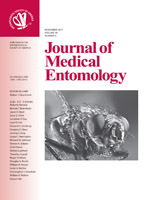Evolutionary theory predicts that virulence of parasites for mobile vector insects will be low for natural parasite-host associations that have coevolved. I determined virulence of the malaria parasite of lizards, Plasmodium mexicanum, for its vectors, two species of sand fly (Diptera: Psychodidae), Lutzomyia vexator (Coquillett 1907) and Lutzomyia stewarti (Mangabeira Fo & Galindo 1944), by measuring several life history traits. Developmental rate from egg to eclosion differed for the two species when noninfected. For both sand fly species, developmental rate for each stage (egg to larval hatching, larval period, pupal period) and life span were not altered by infection. Infected sand flies, however, produced fewer eggs. This reduction in fecundity may be a result of lower quality of the blood meal taken from infected lizards (lower concentration of hemoglobin). This report is the first measure of virulence of Plasmodium for an insect vector other than a mosquito and concords with both expectations of theory and previous studies on natural parasite-host associations that revealed low virulence.
How to translate text using browser tools
1 November 2011
Virulence of a Malaria Parasite, Plasmodium mexicanum, for Its Sand Fly Vectors, Lutzomyia vexator and Lutzomyia stewarti (Diptera: Psychodidae)
Jos. J. Schall
ACCESS THE FULL ARTICLE
It is not available for individual sale.
This article is only available to subscribers.
It is not available for individual sale.
It is not available for individual sale.

Journal of Medical Entomology
Vol. 48 • No. 6
November 2011
Vol. 48 • No. 6
November 2011
parasite virulence
Plasmodium
sand flies




